
Anniversary Day in Woodhaven
Anniversary Day began in 1829 and was a celebration of the founding of the first Sunday School in Brooklyn, pictured below:
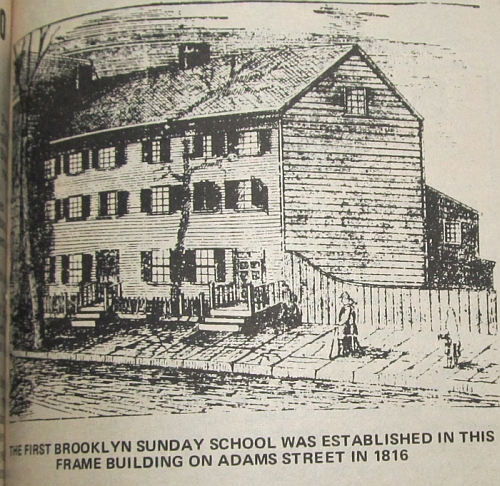
The celebration has undergone some changes over the years (click here for a history of how it became Brooklyn-Queens Day). Here in Woodhaven, Anniversary Day was an important holiday, accompanied by parades and festivities. Last year, Woodhaven resident Madelyn Roesch wrote this wonderful memory of Anniversary Day for the Leader-Observer:
As Emanuel United Church of Christ celebrates its 135th anniversary, our thoughts turn to another anniversary - Anniversary Day, to be exact. Celebrated on the first Thursday in June (if it falls in the same week as Memorial Day, it is celebrated on the second Thursday), it was the “Protestant Holiday" and it was unique to Brooklyn and Queens.Anniversary Day was also a pretty big do for those of us who came of age in the 1950s and ‘60s. There were parades, floats, marching band, not to mention a day off from school. (At least public school. It didn’t become a legal holiday until 1959, and even then only in Brooklyn and Queens.)So, what was the celebration all about? Sunday Schools, where Protestant children learned their Bible verses and “Jesus Loves Me.” The celebration began in 1829 with the founding of the first Sunday School in Brooklyn. It grew with the borough and spread to Queens by 1910, according to most accounts. By then, Sunday Schools had established a Union at which Protestant churches of various denominations shared information, ideas, and most importantly, plans for a parade. Not only was it a first stab at the ecumenical movement, it was also a huge event. Hundreds of churches and tens of thousands of marchers participated along routes that traversed each borough.“The parade and the spirit that inspires it constitute one of the genuinely worthwhile things in the city.” That’s how Governor Herbert Lehman described it in 1937. Although it was a Protestant holiday, churches included Scout troops and other organizations that met in their buildings, so there was a good smattering of Catholics and Jews among the marchers. And probably a few who joined for the cookies and ice cream that always followed the parade.Emanuel’s route ran along 91st Ave. from Woodhaven Blvd. to 84th Street. It included a varying number of churches, at times from as far away as Cypress Hills and Far Rockaway. Their “East End” of the line of the march formed at “the hospital,” St. Anthony’s between 89th and 91st Avenues on Woodhaven Boulevard. Churches included St. Matthew’s Episcopal, Christ Congregational, and Forest Park Reformed, all of them gone now. The march ran parallel to the “West End” that included churches from as far as 101st Ave. (United Presbyterian and Christ Evangelical Lutheran) before turning toward home and those cookies and ice cream.By Macy’s standards, it probably wasn’t much of a parade. By Woodhaven standards, it was an event. There were floats to accommodate the kids from the primary grades, decorated for the theme of each year’s parade and pulled by “volunteers” from the older groups or the Boy Scouts. Mothers of young children decorated baby carriages and strollers. Scouting groups carried flags and churches carried banners identifying themselves and the different groups represented. Bands were hired, hymns were sung. During World War II, churches proudly carried service flags with the names of their “boys” in service. Except in 1943 when the parade was suspended because of the war.The reviewing stand was populated by local luminaries: state assemblymen and senators (Fred Schmidt was a regular attendee), city councilmen, local businessmen, and once, even, the governor.By the 1970s the landscape had changed. If nothing else, your average teenager would rather die than march in a church event. And Protestant churches in Woodhaven were shrinking. As early as 1967, the question was raised about whether to continue the parade.But from adversity came cooperation. Emanuel joined with United Presbyterian Church and Community Methodist in joint service. They marched together and shared the ubiquitous ice cream and cake. Marching bands came from St. Elizabeth’s and Blessed Sacrament Roman Catholic churches. The Protestant holiday had become an ecumenical affair.1972 saw the largest parade in almost a decade with 1,400+ marchers, some from churches in communities where parades had been canceled. Sadly, it was a matter of time.In 1978, the parade in Woodhaven was canceled for unspecified reasons. However, it was revived and continued for another eight years. The last line of march formed at the corner of Woodhaven Boulevard and 91st Avenue on a bright Thursday in June of 1985 the last in a line that began more than 150 years earlier.
Children smile out at the crowd in this picture dating from the 1930s. The floats, pulled by “volunteers” from the older grades and scouting program, were dismantled in 1995.
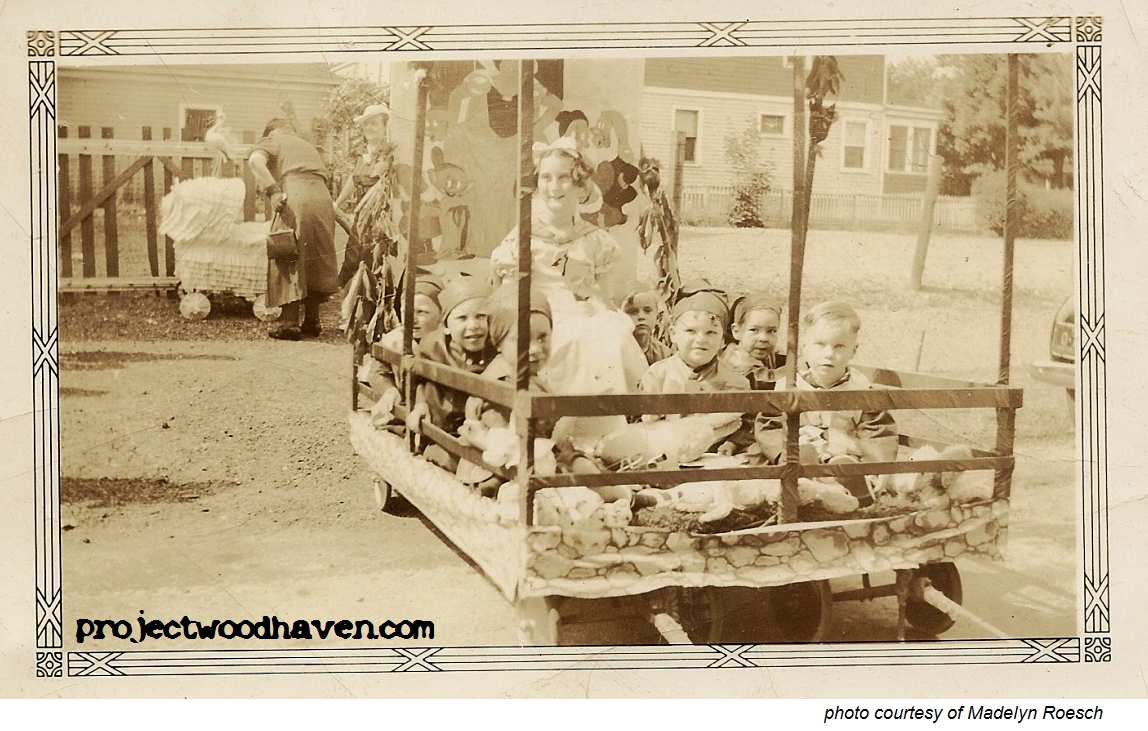
This photo from the early ‘50s shows march at 91st Street and 91st Avenue. The businesses shown in this photo are long gone. Click here to view a super-sized version of this picture.
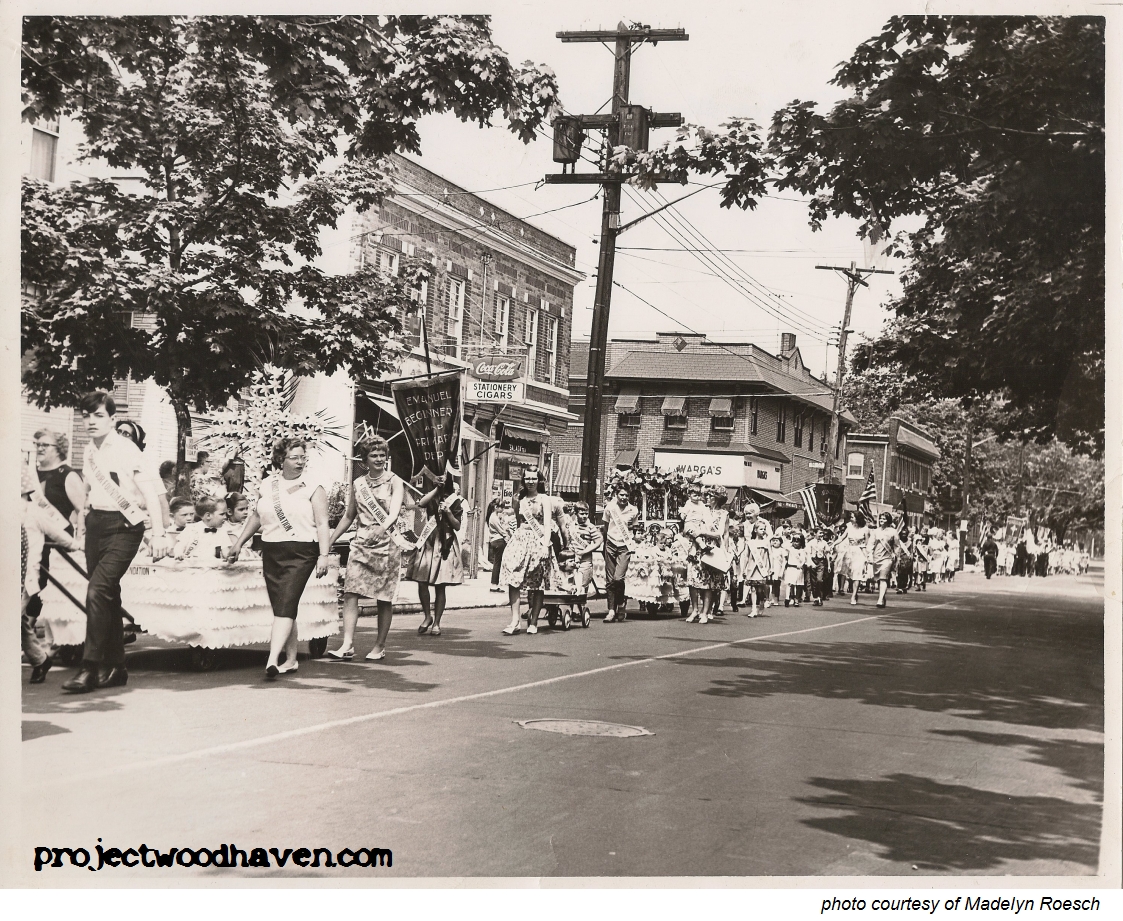
Linda Wilkens, still an active member of Emanuel United Church of Christ (seen in background), gazes out at the crowd in this photo from the ‘50s. The float decorations, made by church school members, had become fairly elaborate.
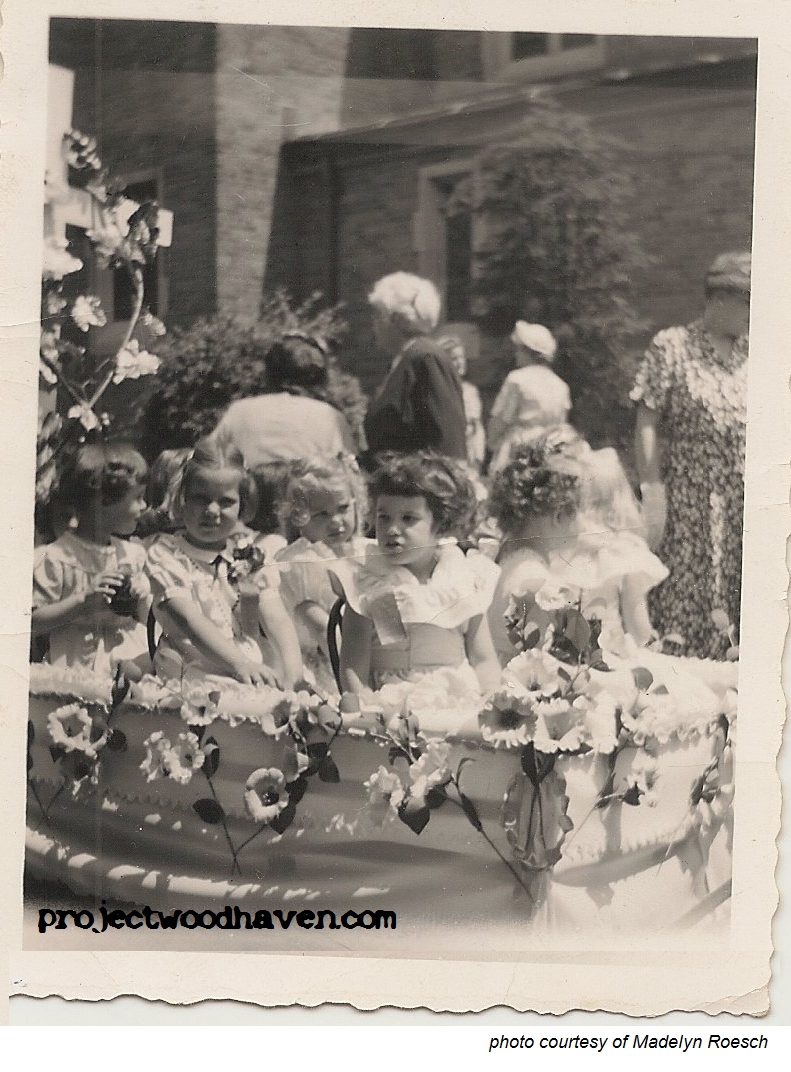
The parade assembles in this 1951 photo. Note the banner in the background identifying the grade.
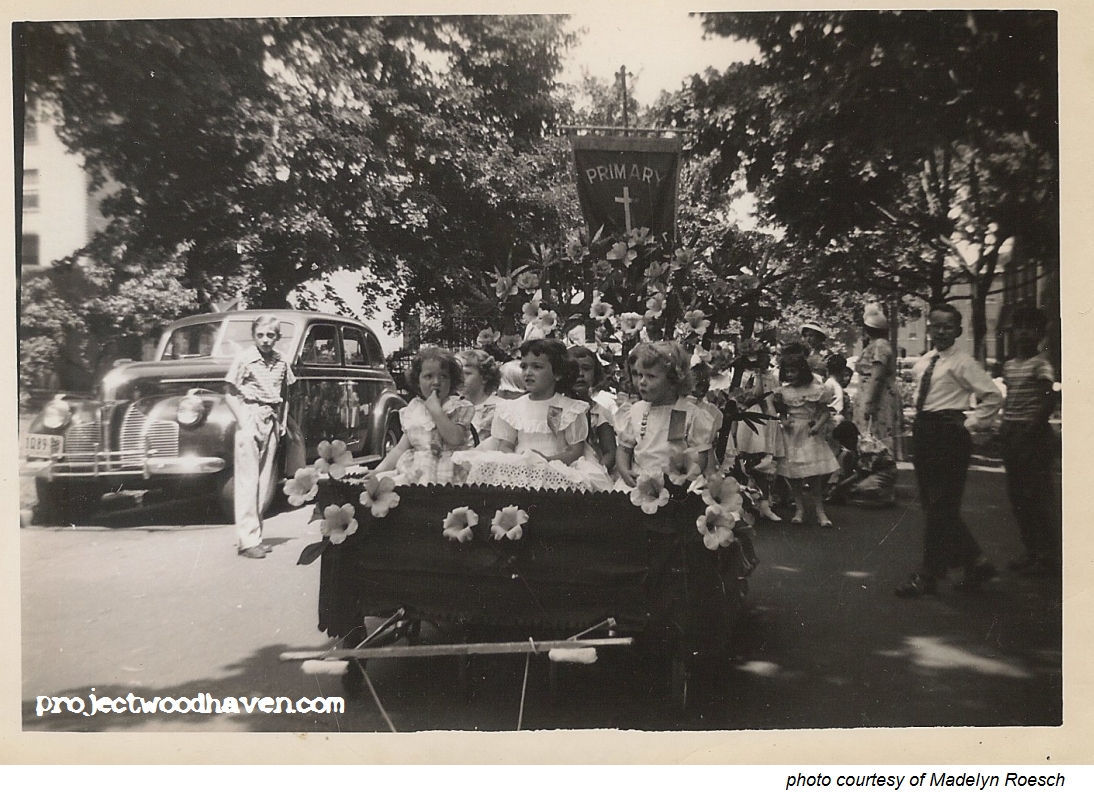
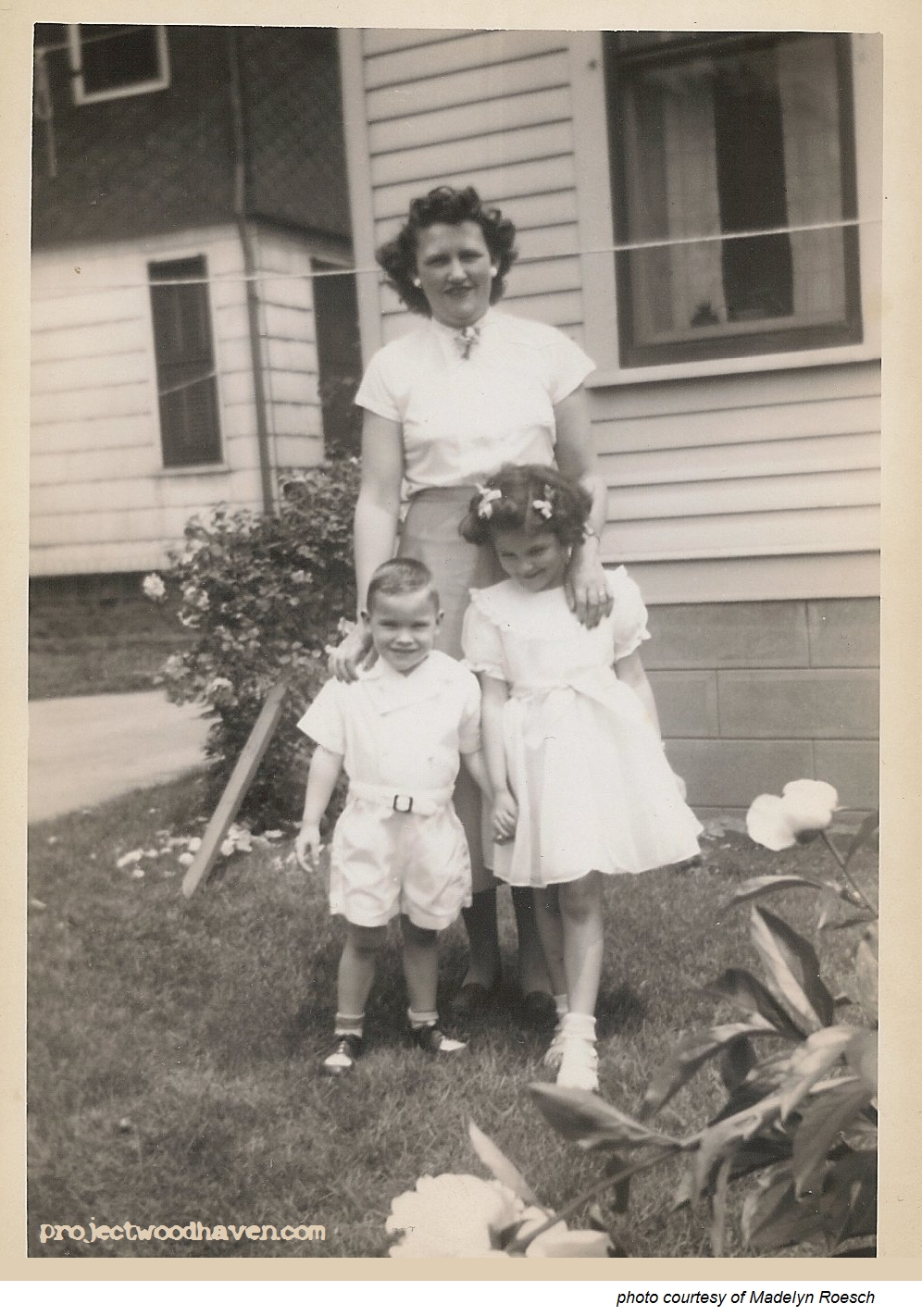
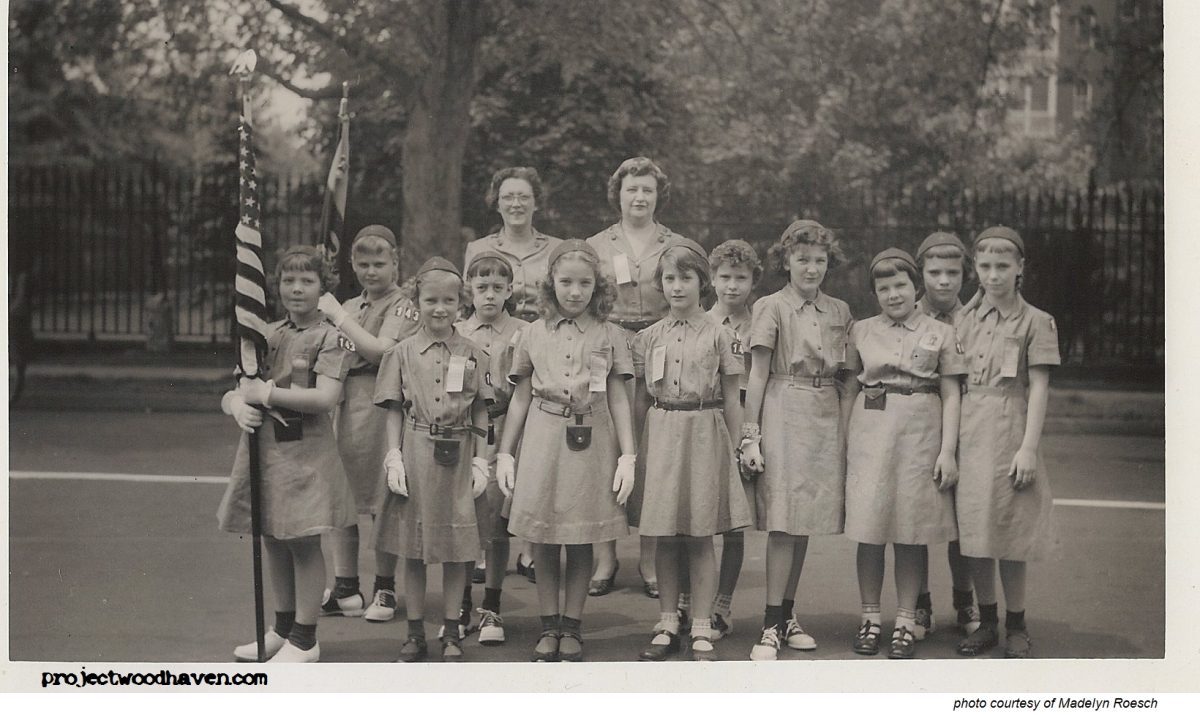
In 1966, Viola Rogers, a well-know member of the Woodhaven community, led her junior class across the Boulevard and into the parade.
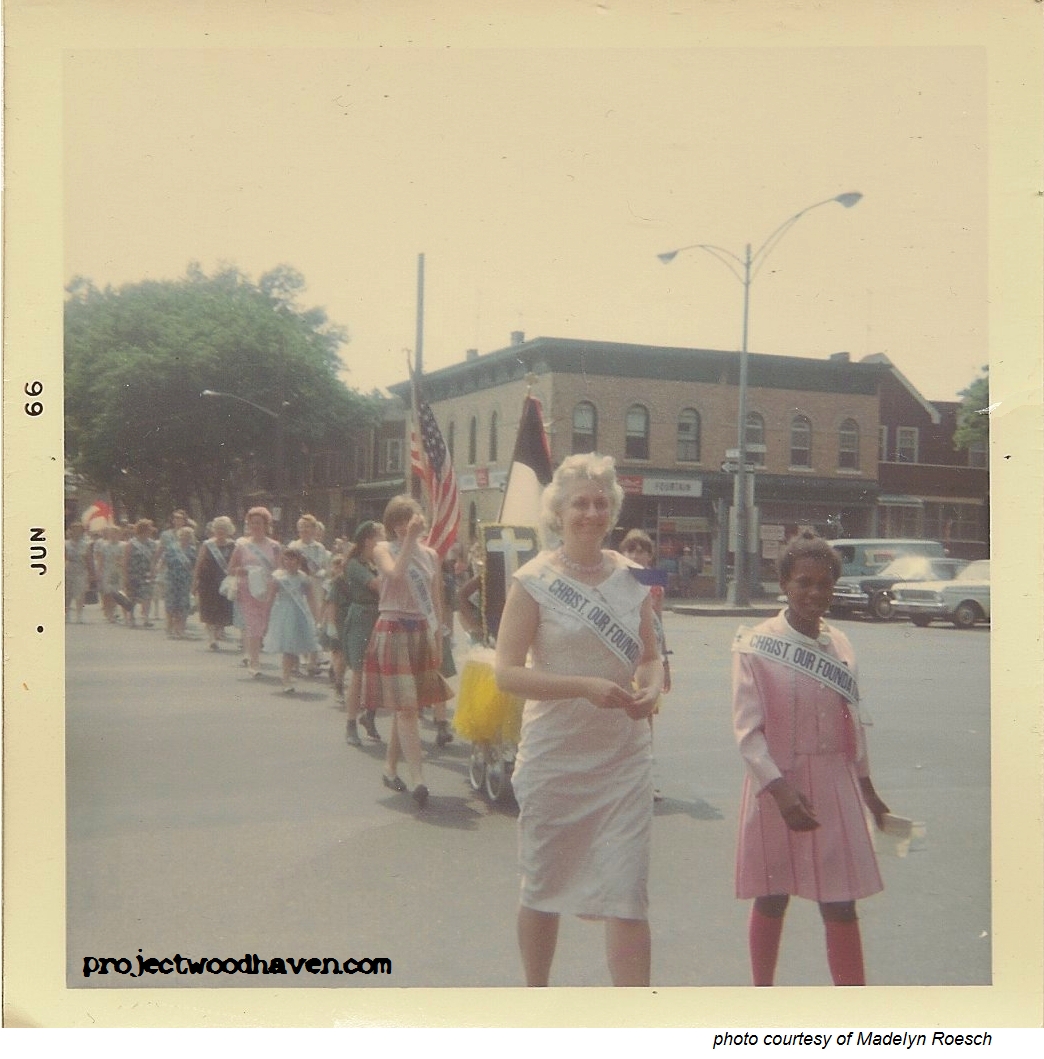
Rev. Truman Stehr, pastor, smiles for the camera while leading the line of march in 1967.
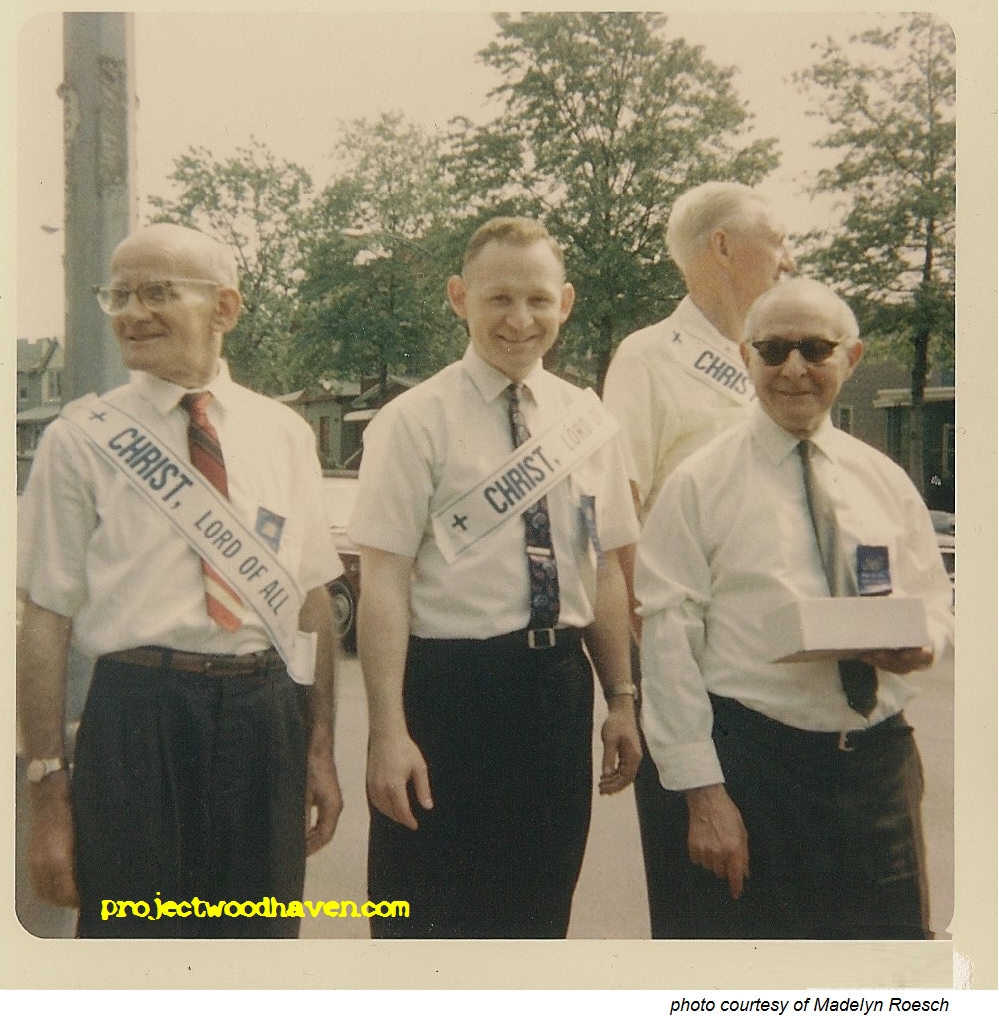
Long-time church secretary Ruth Bittner reminds us of an important precept while some of the junior high boys mug for the camera in the background during the 1967 parade.
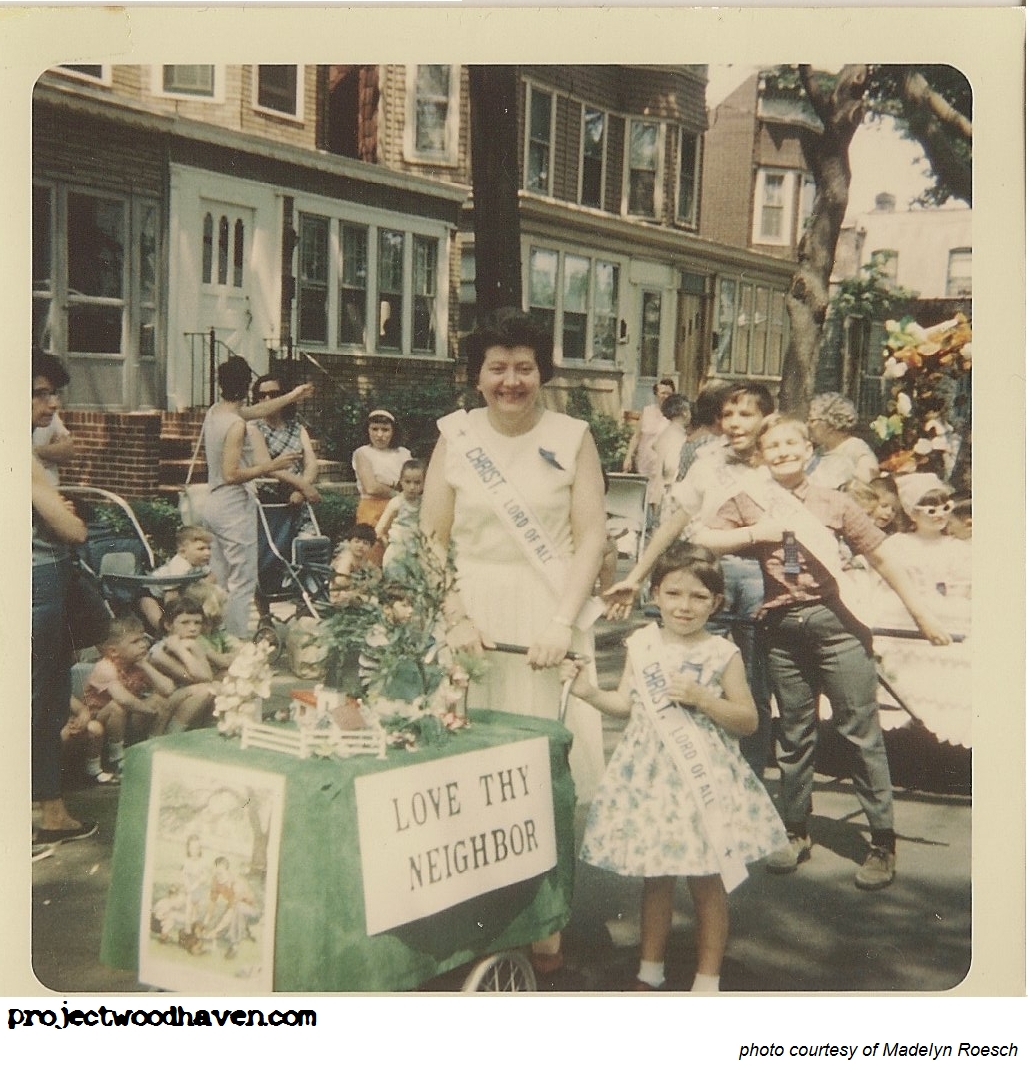
Brownies and Girl Scouts get ready to march, also 1967.
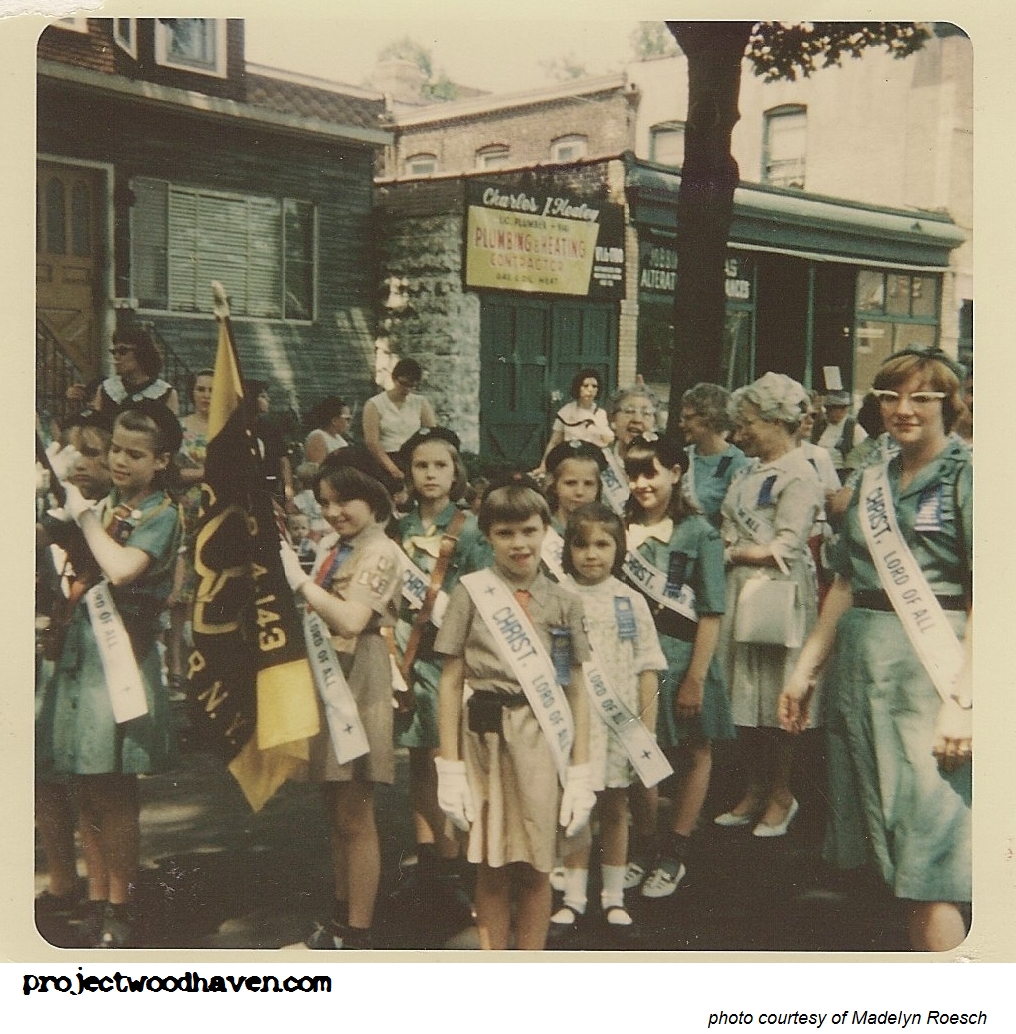
Boy Scout troop 169, founded in the 1930s, marching in 1968.
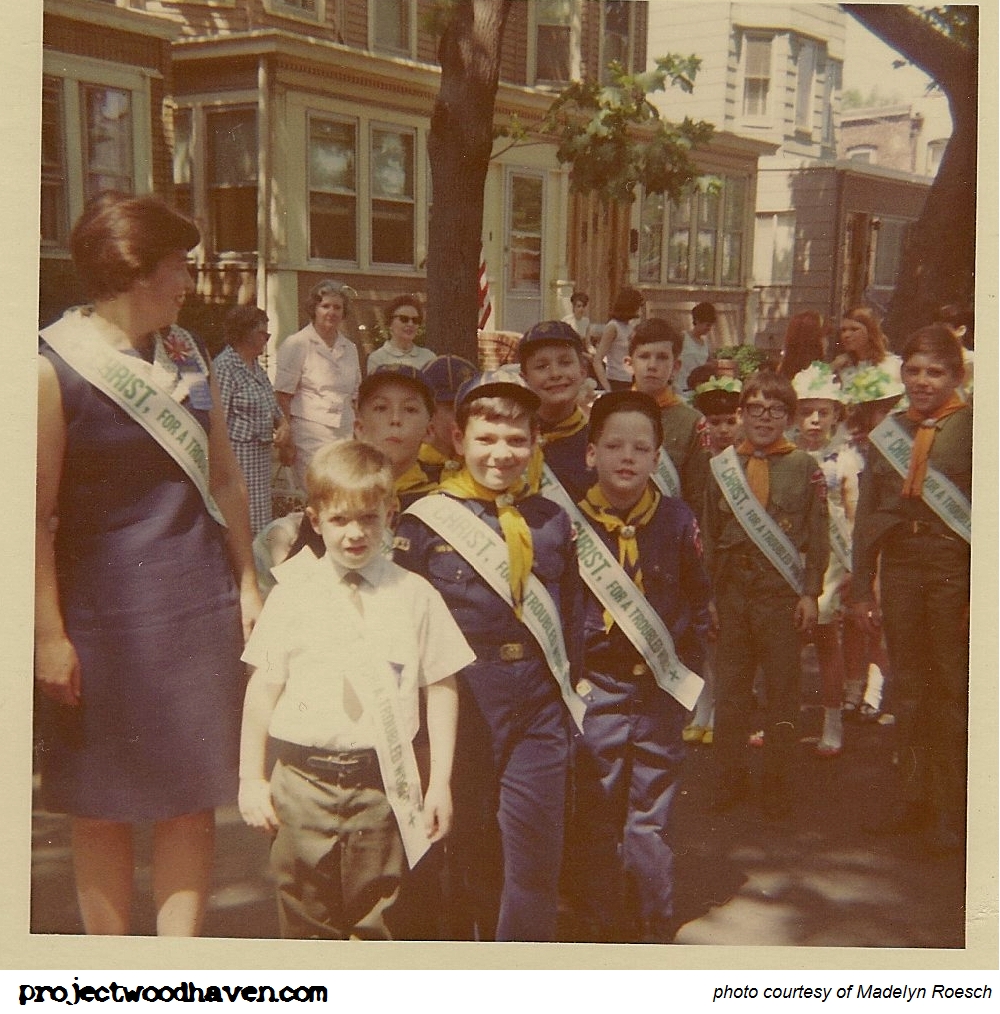
In the 1969 parade, homemade hats were the order of the day for this group, accompanied by (left) Doris Strassle and (right) Margie Stackpoole, both were featured artists with the church’s choir.
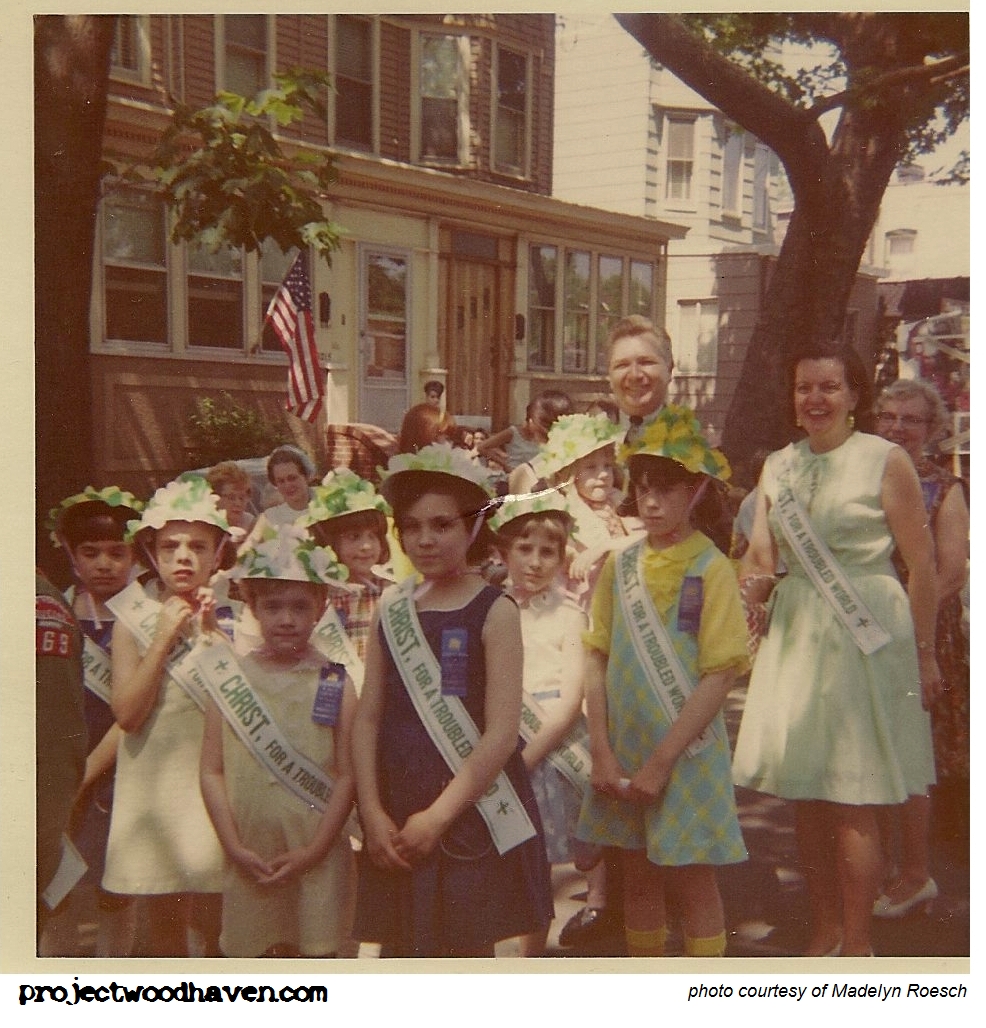
The color guard leads the parade in 1970.
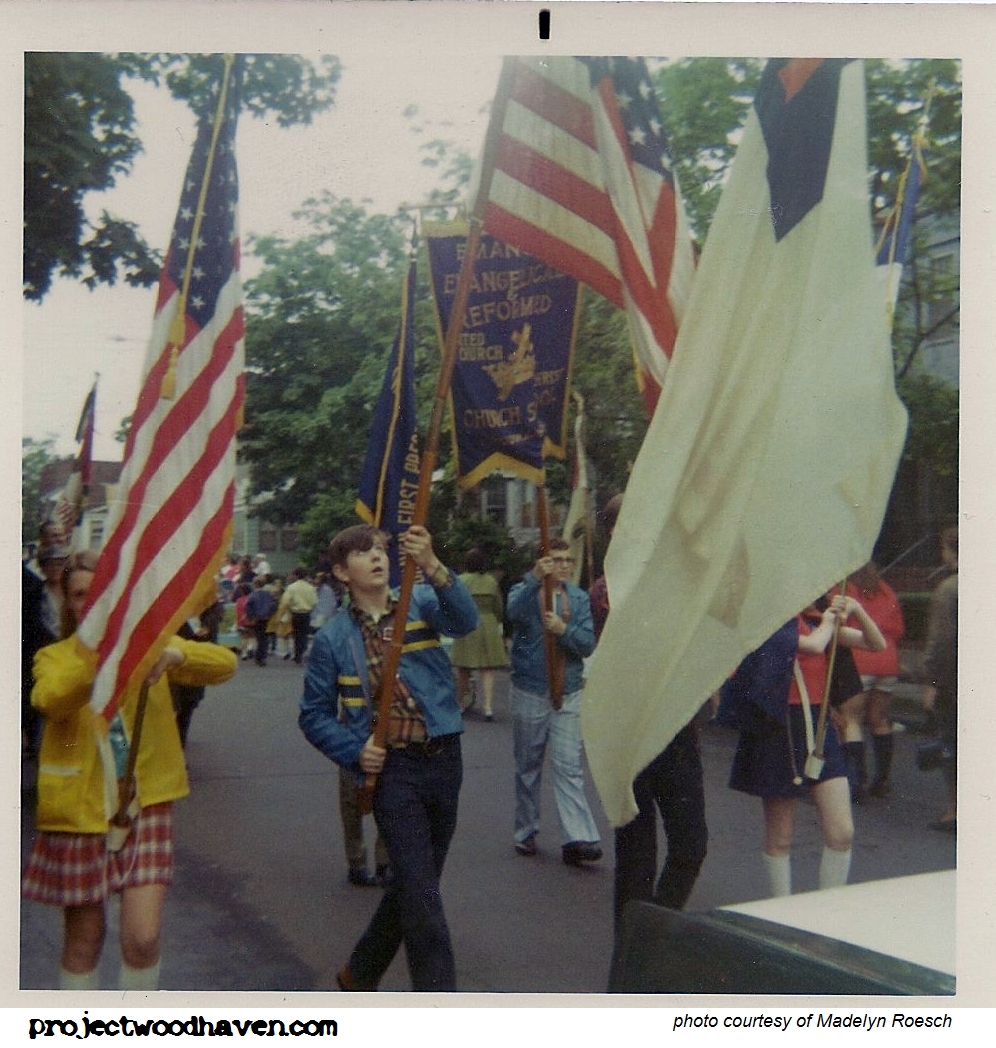
Scott Steffens in the 1985 parade—the last to march along 91st Ave. Scott, a career navy officer, still visits Woodhaven while on shore leave. Parents Pam and Walter serve the church in many capacities.
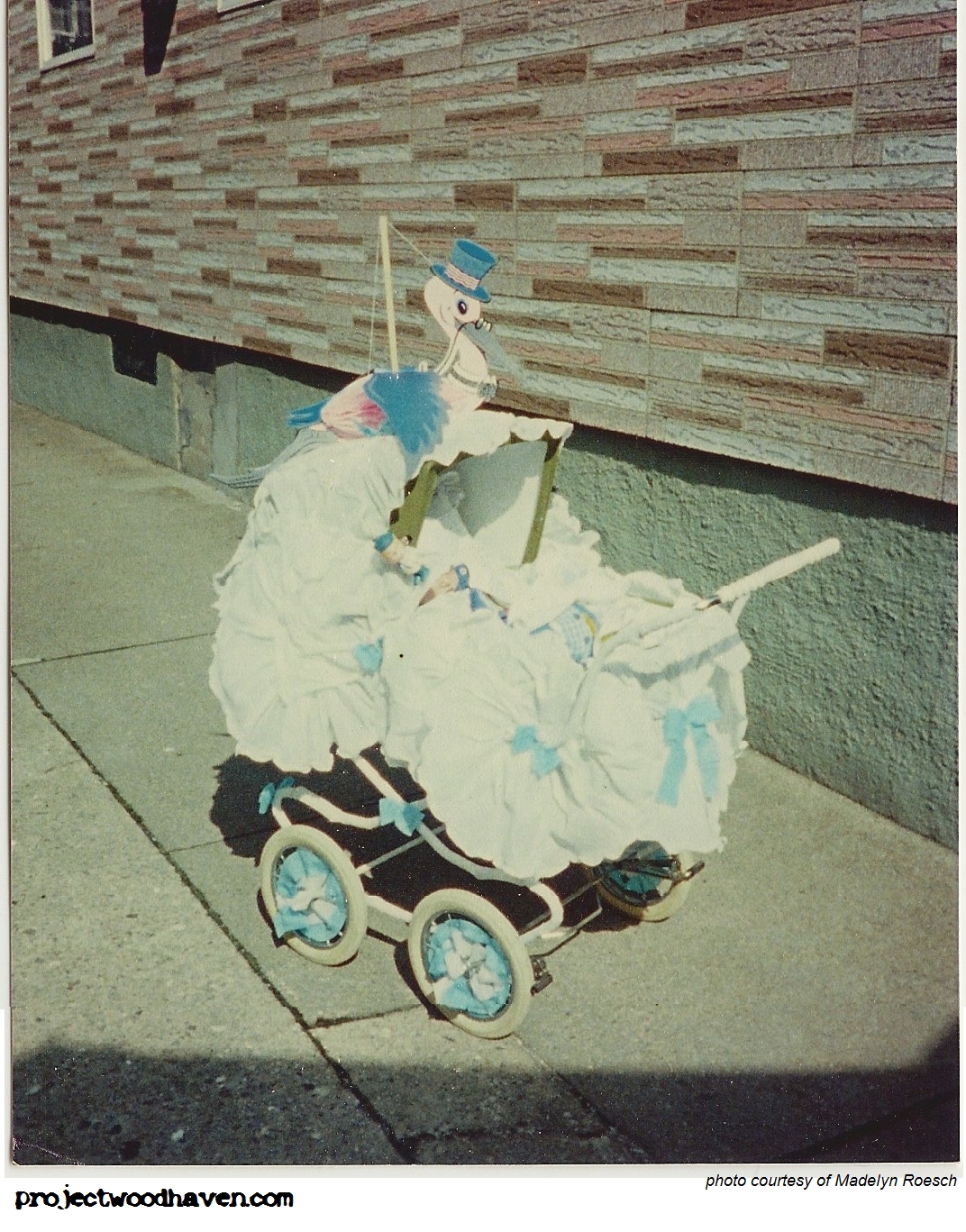
For nearly a century, the Anniversary Day Parade was a huge event here in Woodhaven, receiving plenty of coverage in the Leader-Observer and other local papers - here is a walk down memory lane. Here's a sketch of an Anniversary Day parade in Brooklyn from 1872. As the population shifted east, so did the parades. Woodhaven was the first neighborhood in Queens to hold an Anniversary Day parade (in 1890).
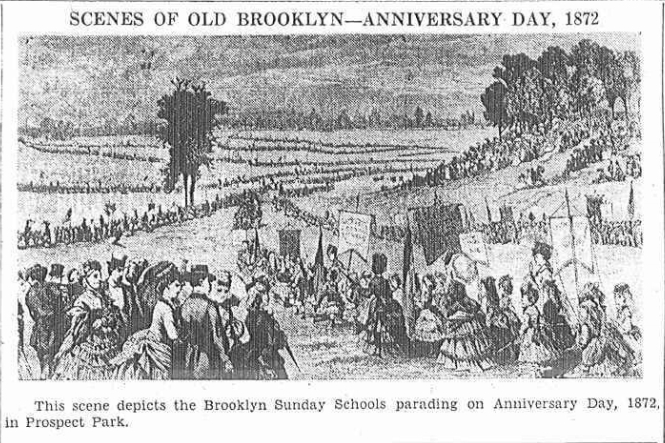
The early Anniversary Day parades in Woodhaven began at each church and they paraded to Jamaica Avenue and Forest Parkway and then marched up to Forest Park. In this clipping form 1916, it notes that over 2,000 children were expected to march.
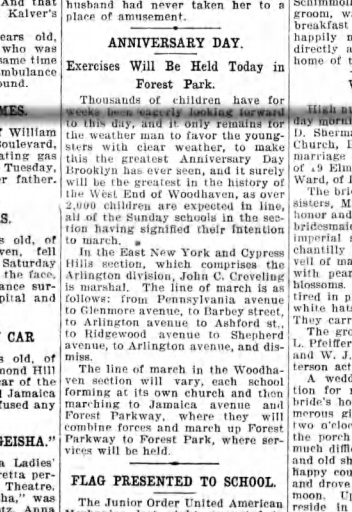
The 1916 Parade was dampened by rain, so the organizers went to the long defunct Manor Theater who opened their doors to the marchers for free.
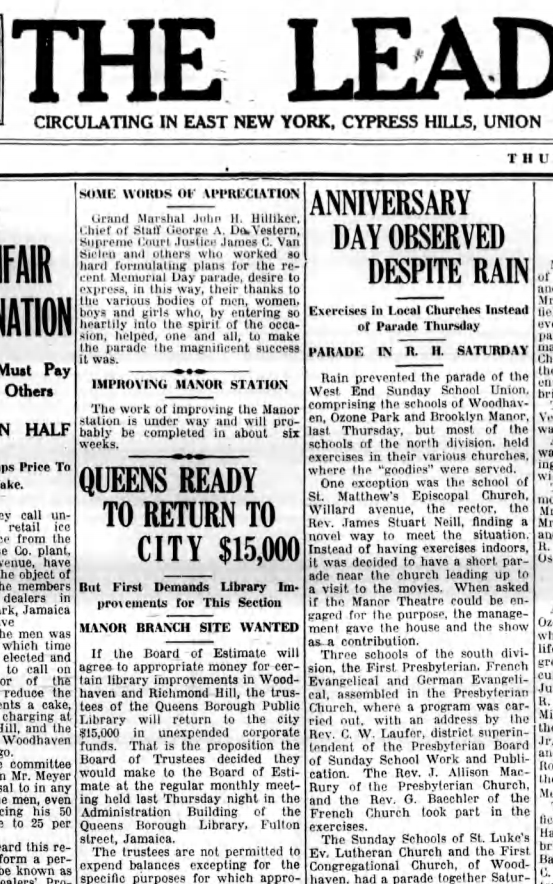
Anniversary Day was a holiday for the schools in Brooklyn from the start - but in Queens it was left up to each individual school, leading to uncertainty each year. In this article from 1917, there is a movement underway to make it a legal holiday in Queens.
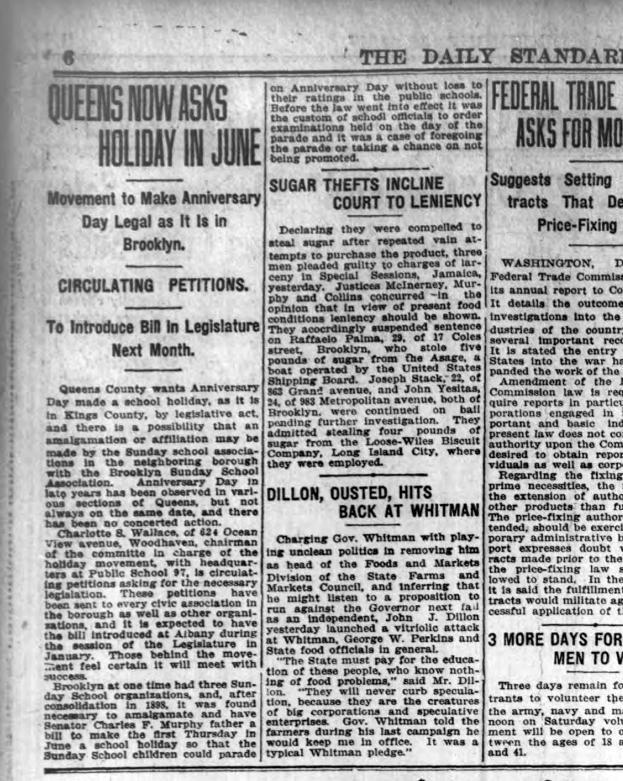
Here is a real early photograph of an Anniversary Day Parade in Woodhaven - 1921!
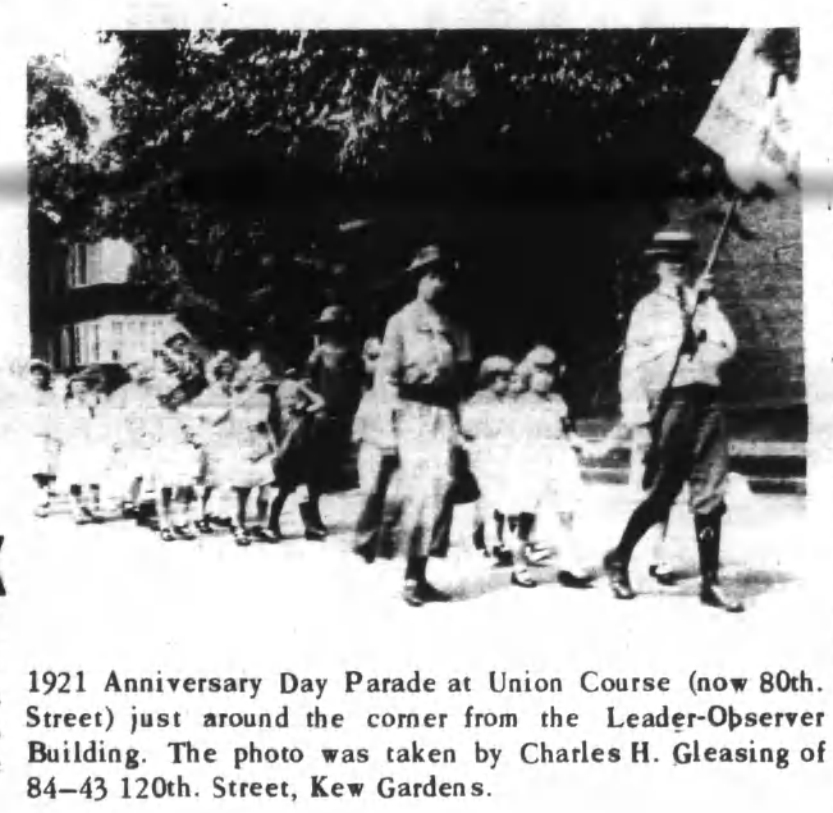
The 1933 Parade made the Long Island Press:
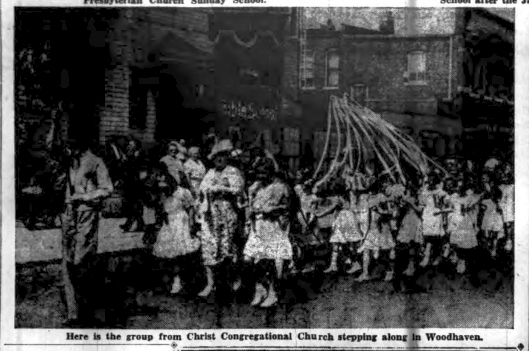
The 1933 Parade had thousands of marchers in Woodhaven:
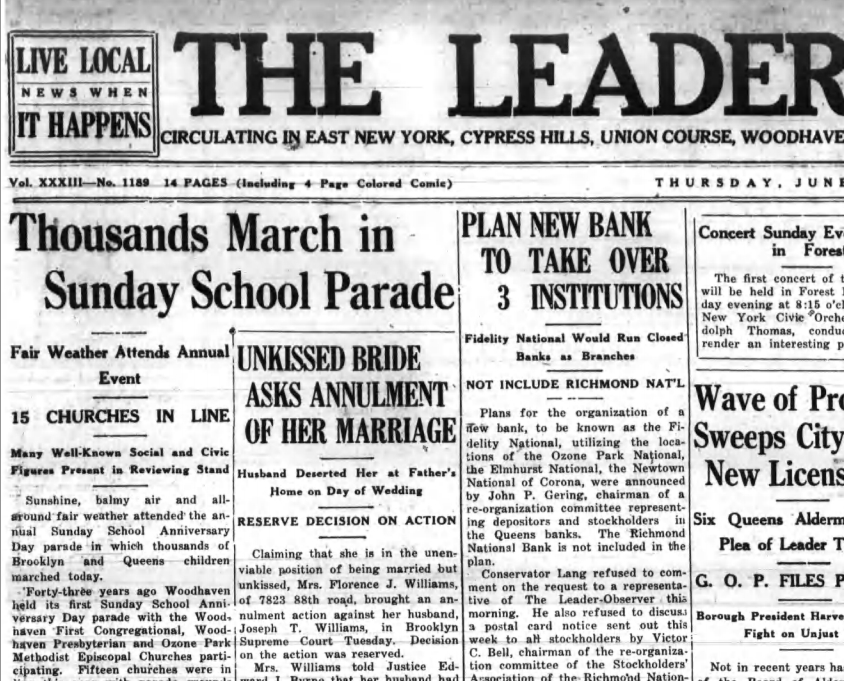
The Emanuel Cradle Roll from the 1934 Parade. It was custom for mothers to decorate their baby carriages in that year's theme.
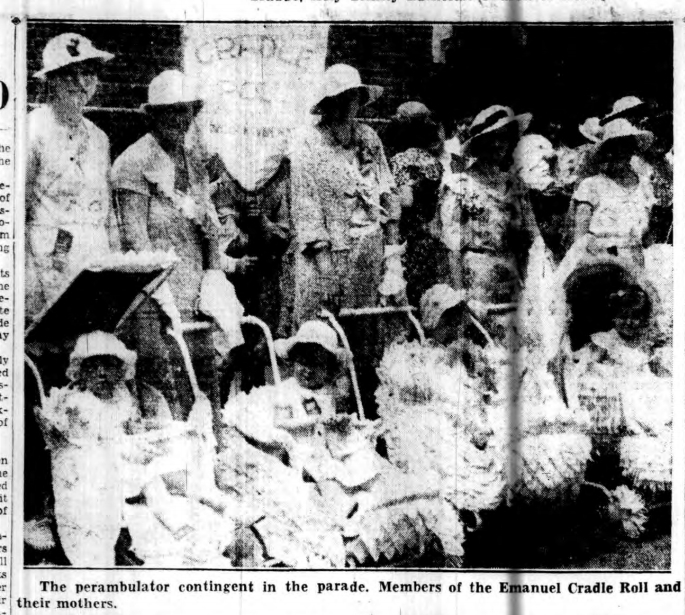
The reviewing stand. The other night at the Woodhaven Research Group meeting (1st Tuesday every month at the Avenue Diner 91-06 Jamaica Avenue), Mr. Allan Smith (a former Marshall of the parade) said the reviewing stand was at 90th Street and 91st Avenue (at the Water Co). Here is the dignitaries of the 1935 parade, including Queens Borough President James Burke. A familiar name in here would be N.H. Walker (of Walker Funeral Home, still in existence).
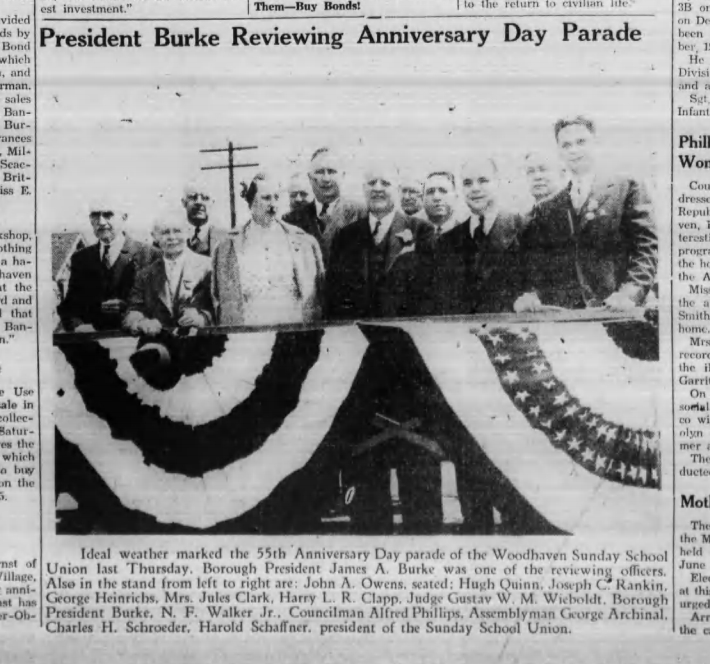
Throngs is such a great word. These were popular parades! Throngs!
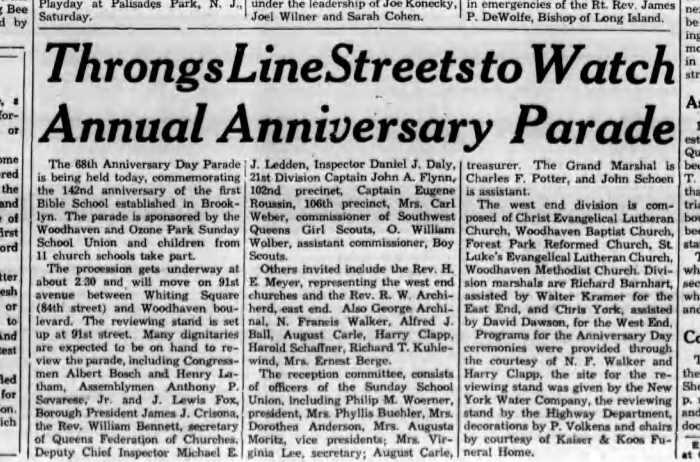
Well, it took over 40 years, but the bill making Anniversary Day a legal holiday in Queens finally passed in 1959. Never give up, never surrender!
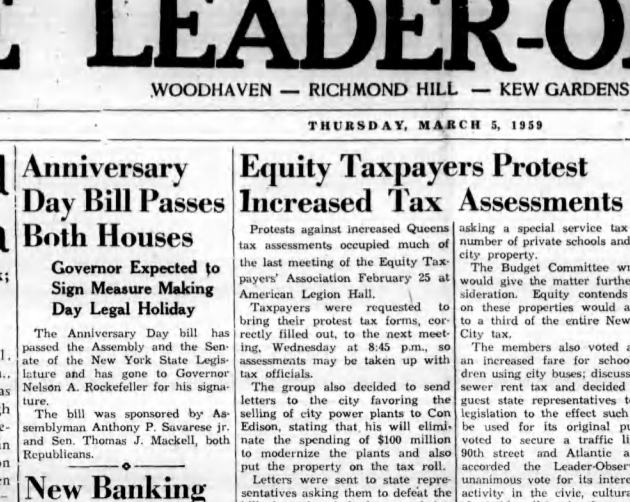
The parades were great opportunities for the Leader to take pictures of the floats and decorations and marchers. This was big, front-page news from year to year.
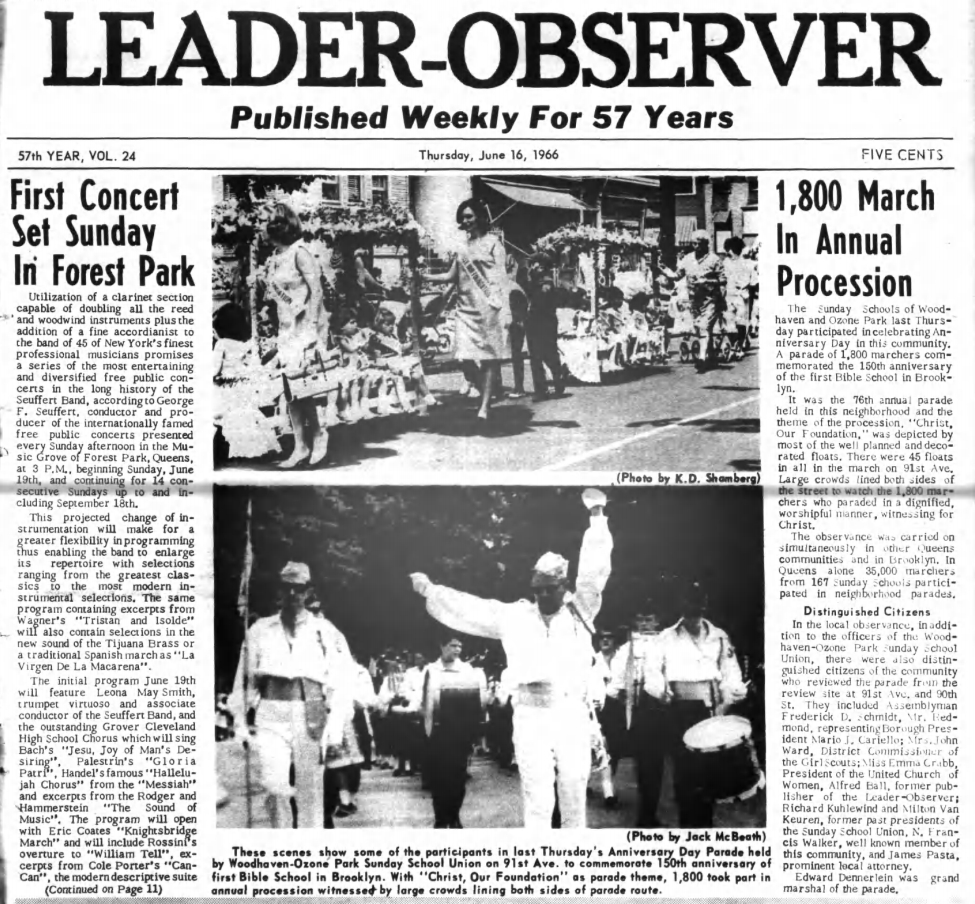
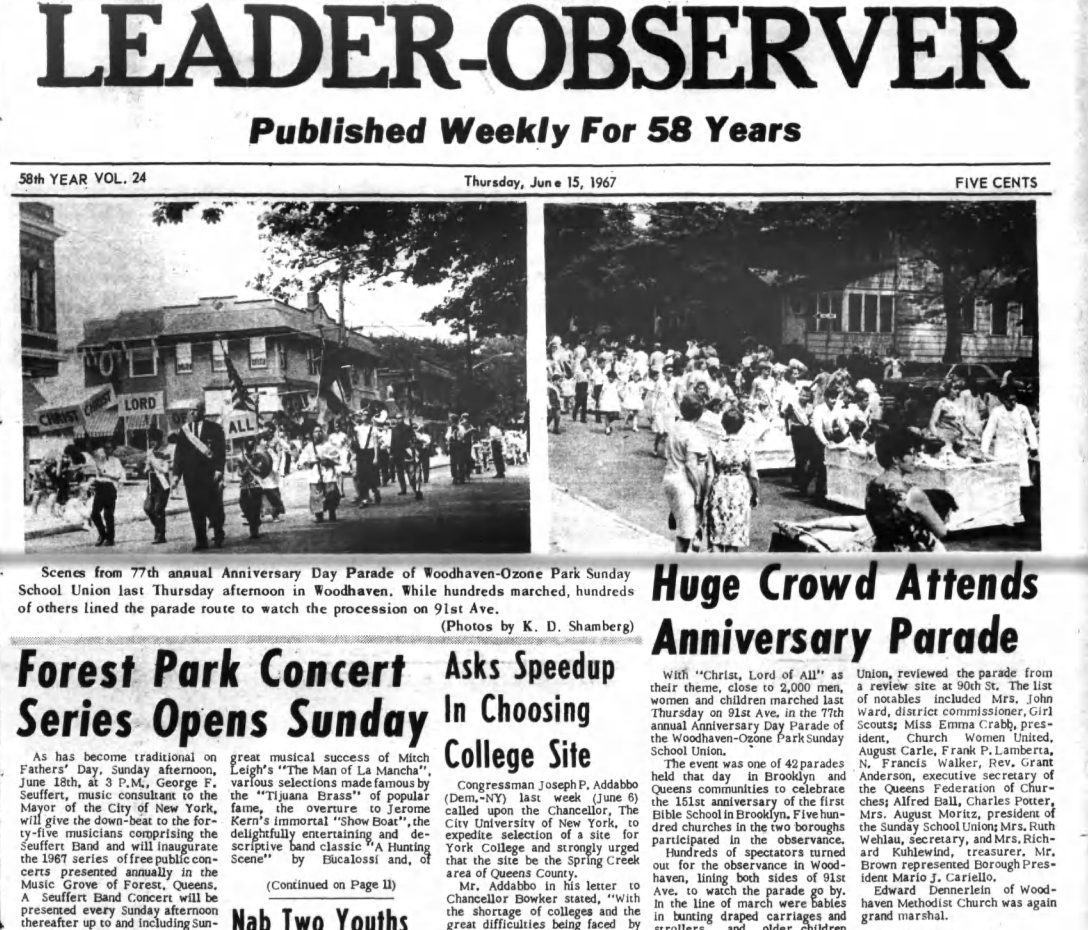
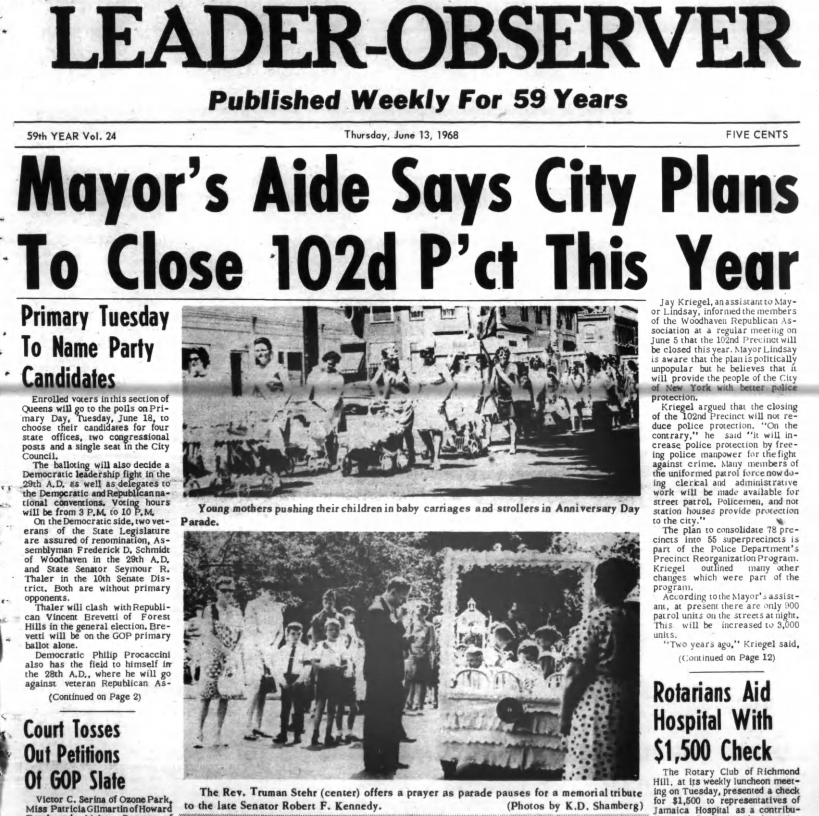
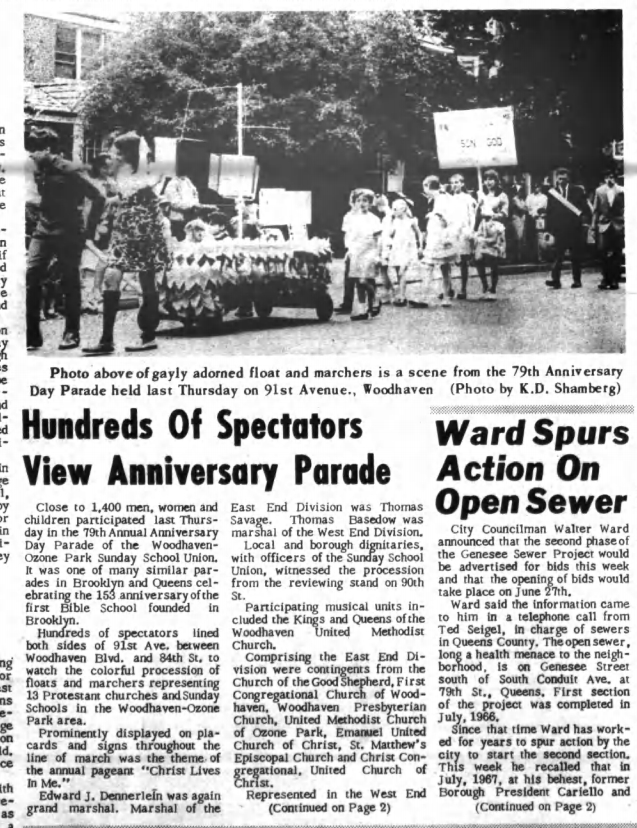
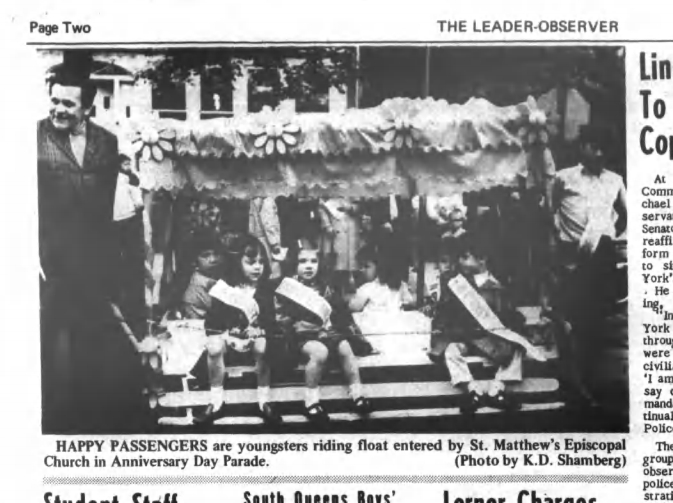
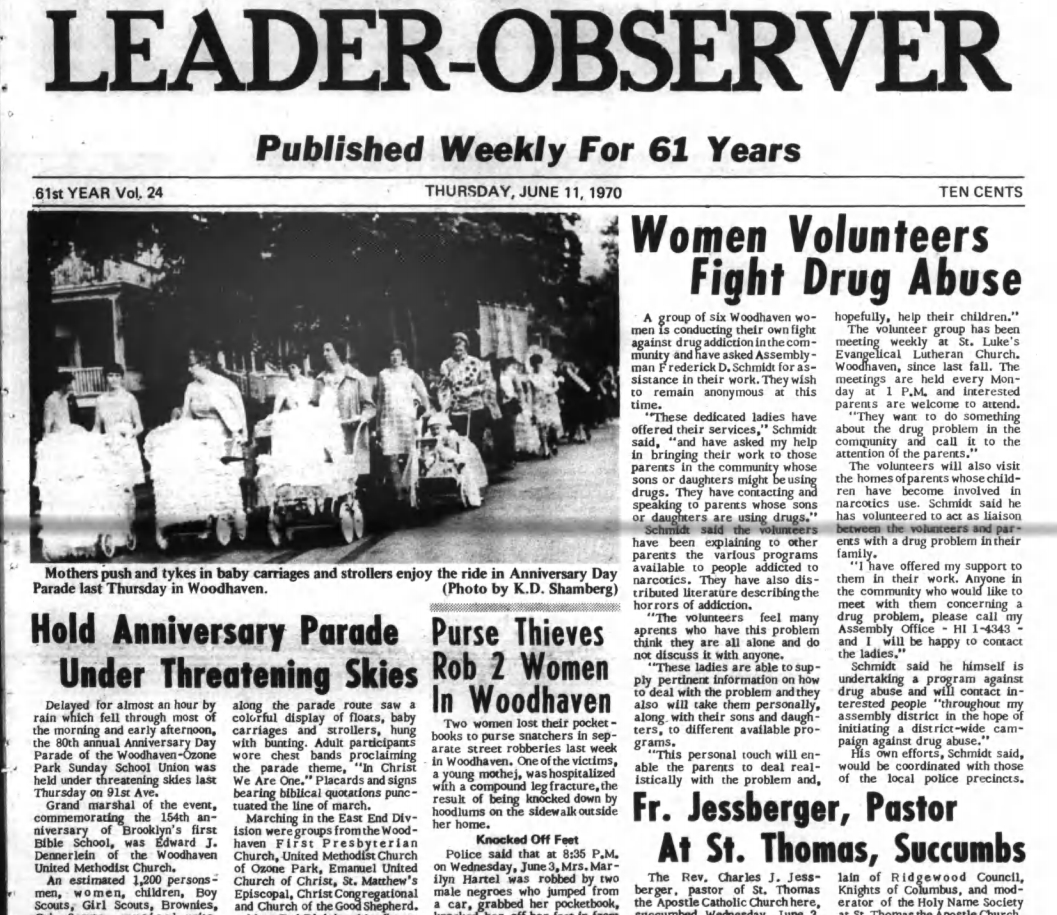
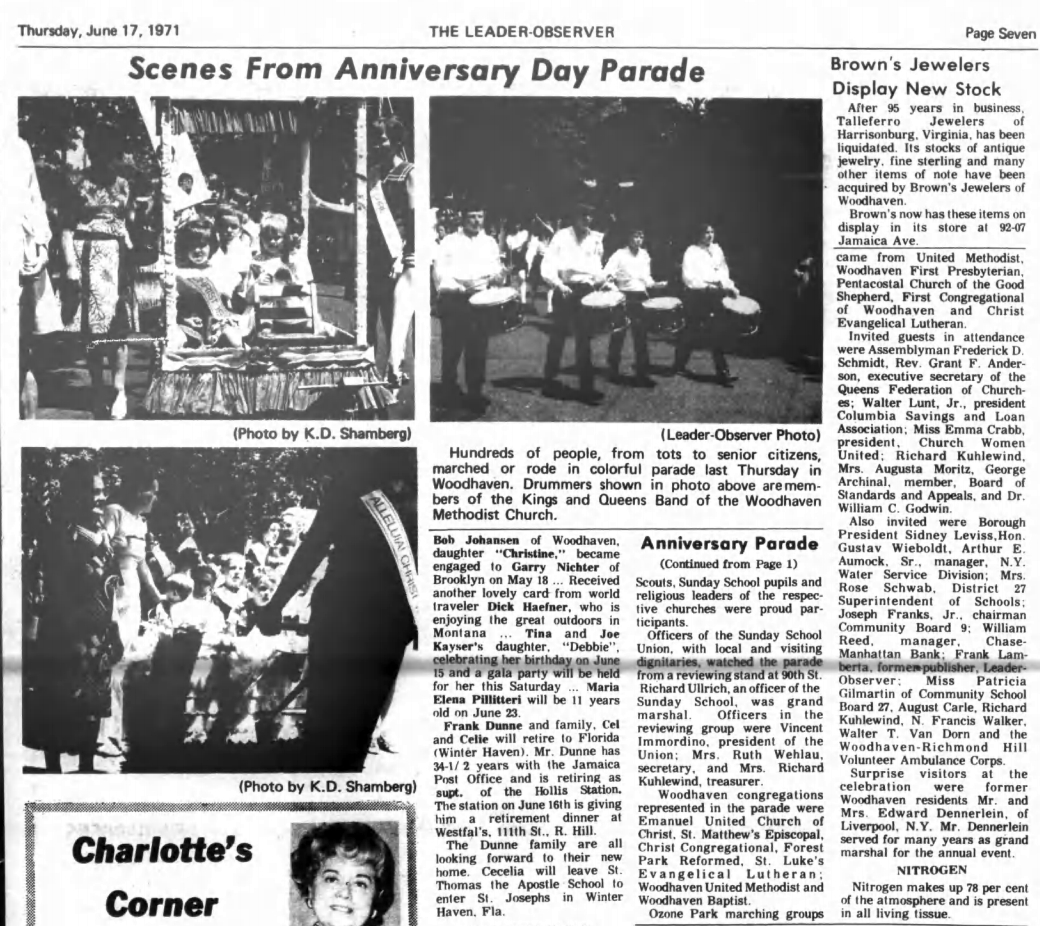
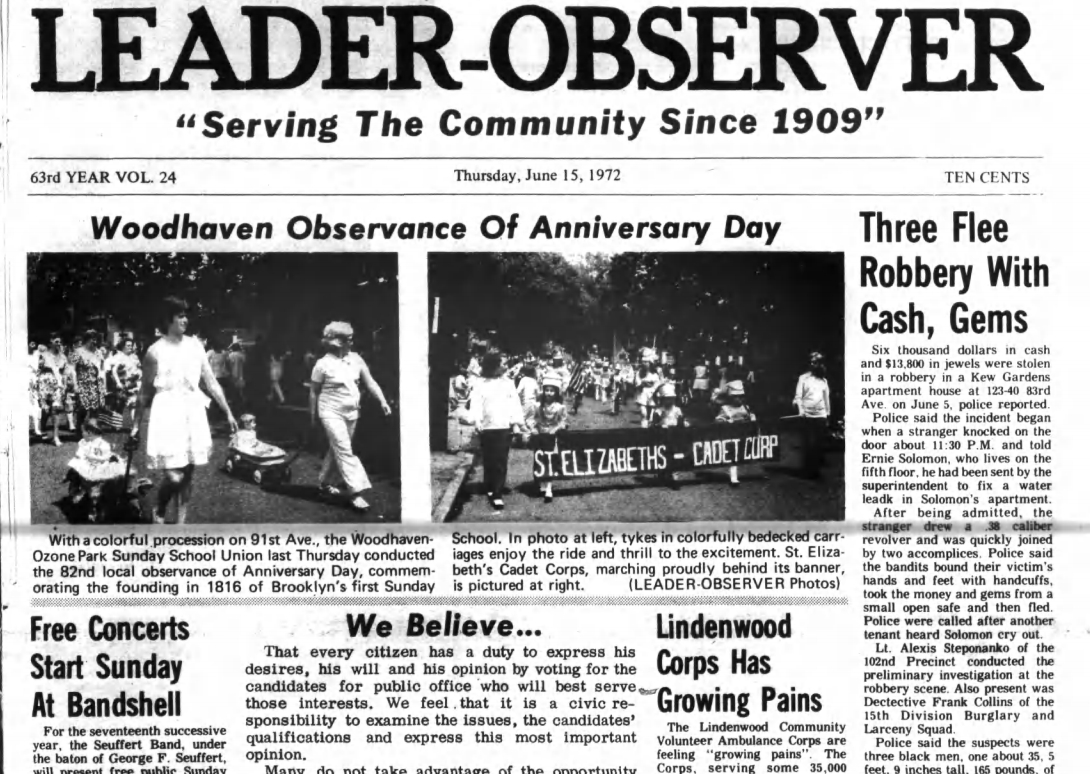
If you have any comments, or would like to suggest other projects, drop us a line at info@projectwoodhaven.com or projectwoodhaven@aol.com.
Return to Project Woodhaven's Home Page
Photos by Joey Wendell